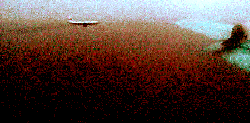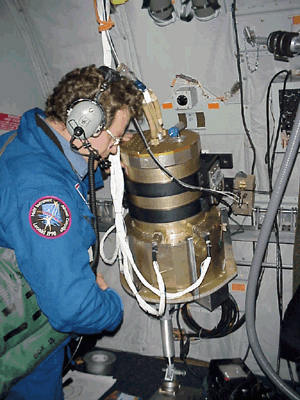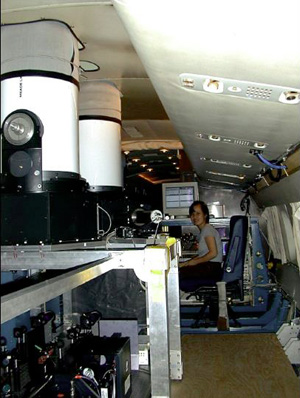|
Leonid MAC |
| home |
| View the shower |
| Mission Brief |
| Science Update |
| Media Brief |
| links |
|
Unofficial release SETI Institute Contact: P. Jenniskens 1-650-6043086
SCIENTISTS REPORT INITIAL RESULTS FROM LEONID OBSERVING CAMPAIGNS Early next week, researchers will meet at NASA/Ames Research
Center to present the initial results from last year's probe of the Leonid meteor shower and discuss observing plans for the next shower in November. This shower will be the final of two chances to observe a meteor storm following
last year's approach of the parent comet to Earth's orbit. The next storm is not due until a century from now.
"We were at the right place at the right time", says Dr. Peter Jenniskens, SETI Institute astronomer and principal investigator of the airborne campaign. "For a short period of time at
the end of the night, the meteor rates went up a hundred per hour. We didn't penetrate deep enough to see a storm, but we did trace more than one dust trail, which has given us valuable insight into how meteor showers are formed." The high rates resulted in a bounty of data to be presented at the Ames workshop. Some of
the debated topics include the activity of the shower, the first detection of molecules, the debris of iron atoms, the heat of meteors, and the first images of meteor contrails, probed by powerful lasers.
"For the first time, we measured how hot the air is heated when a meteoroid blazes by," says Jenniskens. "The meteors are 60 miles up in the atmosphere and are seen hundreds of miles
away and still make your eye's blink! We recorded big flashes that briefly lit up the whole sky! We probed the light of those meteors and from the data, we hope to tell what molecules may have been formed at the time of the origin of life".
"We discovered that the metal atoms deposited by meteors persist much longer in the atmosphere than thought before," says Chet Gardner of the University of Illinois, PI on the lidar experiment onboard the Electra aircraft. Jenniskens added: "This may help us learn how the meteoric debris forms particles that can settle to Earth's surface and catalyze chemical reactions." Gardner also headed a ground-based experiment at the Starfire Optical Range in New Mexico, where meteor contrails were probed by powerful lasers. Detailed video images were obtained that show turbulent gas motions as in aircraft contrails, probing the distorting effects of atmospheric winds at high altitude. These and other initial results will be compared to those of other researchers in the field during the Leonid MAC Workshop. For example, Dr. David Noever and colleagues from the NASA/Marshall Space Flight Center launched a 10m weather balloon into the stratosphere and will will describe In November of this year, Earth makes another close encounter with this dust trail, when a meteor storm may occur over Europe and Africa. At the Leonid MAC Workshop, researchers are planning another airborne campaign. "We are very much aware that this is our last chance at witnessing such impressive event", says Jenniskens. "It will be a hundred years before the next close encounter with the Leonid dust trail." |
||

 The November 17, 1998, Leonid meteor shower was the most intense display of meteors since the storm of 1966. NASA Ames Research Center launched an airborne campaign involving researchers of seven nationalities that probed the meteors
with a range of techniques. This was NASA's first Astrobiology Mission, with the goal of studying the chemistry and physics of extraterrestrial matter falling into Earth's
atmosphere.
The November 17, 1998, Leonid meteor shower was the most intense display of meteors since the storm of 1966. NASA Ames Research Center launched an airborne campaign involving researchers of seven nationalities that probed the meteors
with a range of techniques. This was NASA's first Astrobiology Mission, with the goal of studying the chemistry and physics of extraterrestrial matter falling into Earth's
atmosphere.
 Heat-seeking telescopes of the Aerospace Corporation onboard the FISTA aircraft in the mission made an effort to detect the heat of meteors and measure how fast the gas cools off. According to Jenniskens: "The faster the cooling, the more exotic molecules can be created." FISTA is a US Air Force aircraft and operated by the 452nd Flight Test Squadron at Edwards Air Force Base.
Heat-seeking telescopes of the Aerospace Corporation onboard the FISTA aircraft in the mission made an effort to detect the heat of meteors and measure how fast the gas cools off. According to Jenniskens: "The faster the cooling, the more exotic molecules can be created." FISTA is a US Air Force aircraft and operated by the 452nd Flight Test Squadron at Edwards Air Force Base. The University of Illinois fielded two powerfull lasers onboard the second aircraft in the mission, the Electra. The lasers probed the debris left behind in the path of the meteors. Electra is a National Science Foundation facility and was operated by the National Center for Atmospheric Research.
The University of Illinois fielded two powerfull lasers onboard the second aircraft in the mission, the Electra. The lasers probed the debris left behind in the path of the meteors. Electra is a National Science Foundation facility and was operated by the National Center for Atmospheric Research.